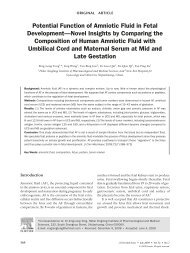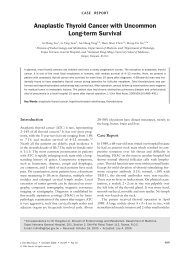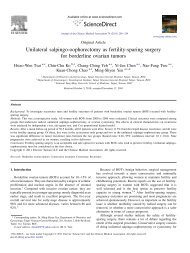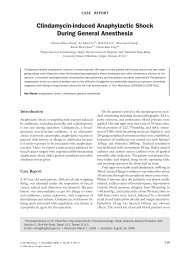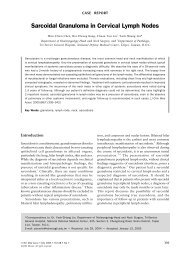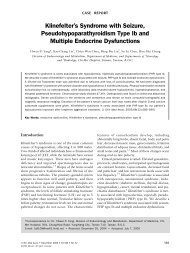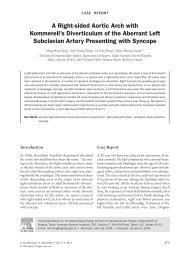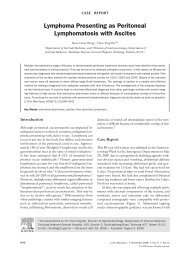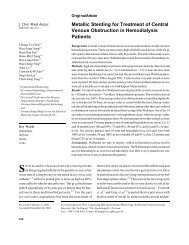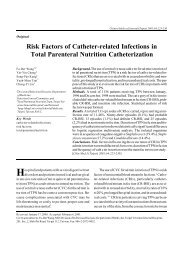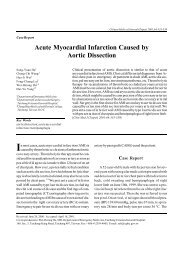Surgical Anatomy of Supratentorial Midline Lesions
Surgical Anatomy of Supratentorial Midline Lesions
Surgical Anatomy of Supratentorial Midline Lesions
You also want an ePaper? Increase the reach of your titles
YUMPU automatically turns print PDFs into web optimized ePapers that Google loves.
FIGURE 5. Branches <strong>of</strong> the pericallosal artery that supply the corpus callosum. A, a photograph showing the body <strong>of</strong> the corpus callosum ( B)<br />
after an interhemispheric approach. Forceps retract the left pericallosal artery to show the origin <strong>of</strong> the callosal artery( arrow), which arises<br />
from the left A4 segment and directly supplies the superficial surface <strong>of</strong> the corpus callosum in the midline, without giving branches to the<br />
depths <strong>of</strong> the callosal sulcus. B, the medial surface <strong>of</strong> the right cerebral hemisphere. After partial removal <strong>of</strong> the cingulate gyrus ( CG), the<br />
callosal sulcus is revealed. Forceps retract the right pericallosal artery. The cingulocallosal arteries ( arrows) arise from the inferolateral aspect<br />
<strong>of</strong> the pericallosal artery, run laterally into the callosal sulcus, and form a portion <strong>of</strong> the pericallosal pial plexus. B, body <strong>of</strong> corpus callosum;<br />
SP, septum pellucidum. C, the medial surface <strong>of</strong> the right cerebral hemisphere. After partial removal <strong>of</strong> the cingulate gyrus( CG), the callosal<br />
sulcus is revealed. The pericallosal artery courses in the cingulate sulcus ( CS). The long callosal artery ( arrow) arises from the pericallosal<br />
artery, supplies the body ( B) and splenium(S) <strong>of</strong> the corpus callosum. It is the major contributor to the pericallosal pial plexus ( PP).CN,<br />
caudate nucleus; F, fornix;G, genu <strong>of</strong> corpus callosum. D, the medial surface <strong>of</strong> the right cerebral hemisphere. After partial removal <strong>of</strong> the<br />
cingulate gyrus (CG), the callosal sulcus is revealed. Forceps retract the A5 segment <strong>of</strong> the pericallosal artery. The posterior extension ( arrow)<br />
<strong>of</strong> the A5 segment follows a corkscrew-like course within the callosal sulcus at the splenium( S) and forms the dense portion <strong>of</strong> the pericallosal<br />
pial plexus (PP). B, body <strong>of</strong> corpus callosum; CP, choroid plexus; F, fornix.<br />
FIGURE 10. Lateral projection <strong>of</strong> a left vertebral artery angiogram showing the distal type <strong>of</strong> posterior pericallosal artery ( black arrow), which<br />
runs to the splenium ( S) and divides into two main branches. The superior branch ( white arrowhead) courses within the callosal sulcus with a<br />
characteristic tortuousity and anastomoses with the posterior extension <strong>of</strong> the A5 segment. The inferior branch ( black arrowhead) runs<br />
anteriorly and anastomoses with the branches <strong>of</strong> the medial posterior choroidal artery( white arrow) in the tela choroidea <strong>of</strong> the third ventricle .<br />
In other instances where one or more <strong>of</strong> the A3 through A5 segments coursed in the cingulate sulcus and were, therefore, not involved with<br />
the corpus callosum, the prominent blood supply to the affected portions <strong>of</strong> the corpus callosum was provided by the median callosal artery, the<br />
long callosal artery, the opposite hemisphere's pericallosal artery, or any combination <strong>of</strong> these arteries. When the A5 segment coursed in the<br />
cingulate sulcus (35%), these arteries subsequently anastomosed with the posterior pericallosal artery in the splenial region (Fig. 5C).



